Jacanas, also known as “lily-trotters” or “Jesus birds” due to their remarkable ability to walk on floating vegetation, is a family of tropical wading birds found in wetlands and shallow lakes worldwide.
Characterized by their long legs, elongated toes, and striking plumage, jacanas are renowned for their unique mating system, where males incubate eggs and care for chicks.
At the same time, females defend territories and seek out additional mates. Their diet primarily consists of insects, small invertebrates, and seeds, which they forage for in their aquatic habitats.
Despite their delicate appearance, jacanas are adept swimmers and highly adapted to their watery environments.
Their fascinating behaviors and intricate ecological roles make them subjects of interest for bird enthusiasts and researchers alike.
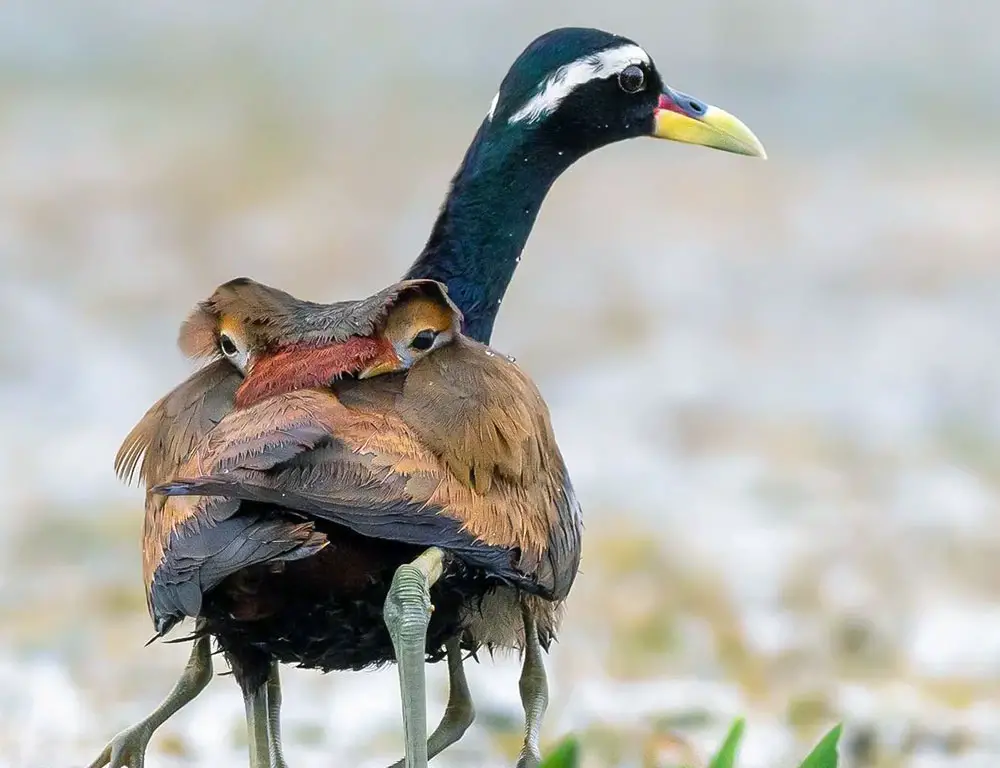
Identical Characteristics of Jacanas
Identifying a Jacana in the wild can be an exciting endeavor for birdwatchers and nature enthusiasts alike. While these birds share some similarities with other wading birds, they possess several distinct characteristics that set them apart.
Here are eight key points to help you identify a Jacana:
Long Legs and Toes
One of the most distinctive features of Jacanas is their long legs and toes. These adaptations allow them to walk on floating vegetation, earning them the nickname “lily-trotters.”
Their toes are significantly elongated, helping them distribute their weight evenly on the surface of water lilies and other aquatic plants.
Slender Body
Jacanas have a slender body shape, aiding their ability to navigate through dense vegetation in their wetland habitats. Their streamlined form allows them to move swiftly and gracefully across the water’s surface.
Colorful Plumage
Depending on the species, Jacanas can exhibit vivid plumage, often characterized by shades of brown, black, and white, with splashes of vivid colors such as blue, green, or red on their wings and tails.
These striking colors are more pronounced in males during the breeding season and serve to attract mates.
Distinctive Facial Features
Jacanas typically have a distinctive facial pattern, including a prominent white or light-colored stripe above the eye and a dark-colored patch around the eye. These markings help accentuate their eyes and add to their overall appearance.
Long, Thin Bill
Jacanas have a long, thin bill that is well-suited for probing into mud and vegetation for food. Their bills are adapted for catching small invertebrates, insects, seeds, and other aquatic prey items.
Behavioral Cues
Observing the behavior of a bird can also aid in identification. Jacanas are often seen foraging along the edges of wetlands, probing the mud and vegetation with their bills in search of food.
They may also be observed walking delicately on floating vegetation or swimming in shallow water.
Habitat Preference
Jacanas are typically found in tropical and subtropical wetlands, including marshes, swamps, and shallow lakes with abundant vegetation. They prefer habitats with ample aquatic vegetation for foraging and nesting.
Size and Shape
While sizes can vary among species, Jacanas are generally small to medium-sized wading birds, with a length ranging from about 8 to 12 inches (20 to 30 centimeters).
Their body shape is elongated, with a slender neck and long legs, giving them a distinctive silhouette.
By paying attention to these critical characteristics, birdwatchers can confidently identify Jacanas and appreciate their unique adaptations for life in wetland environments.
Taxonomy of Jacanas
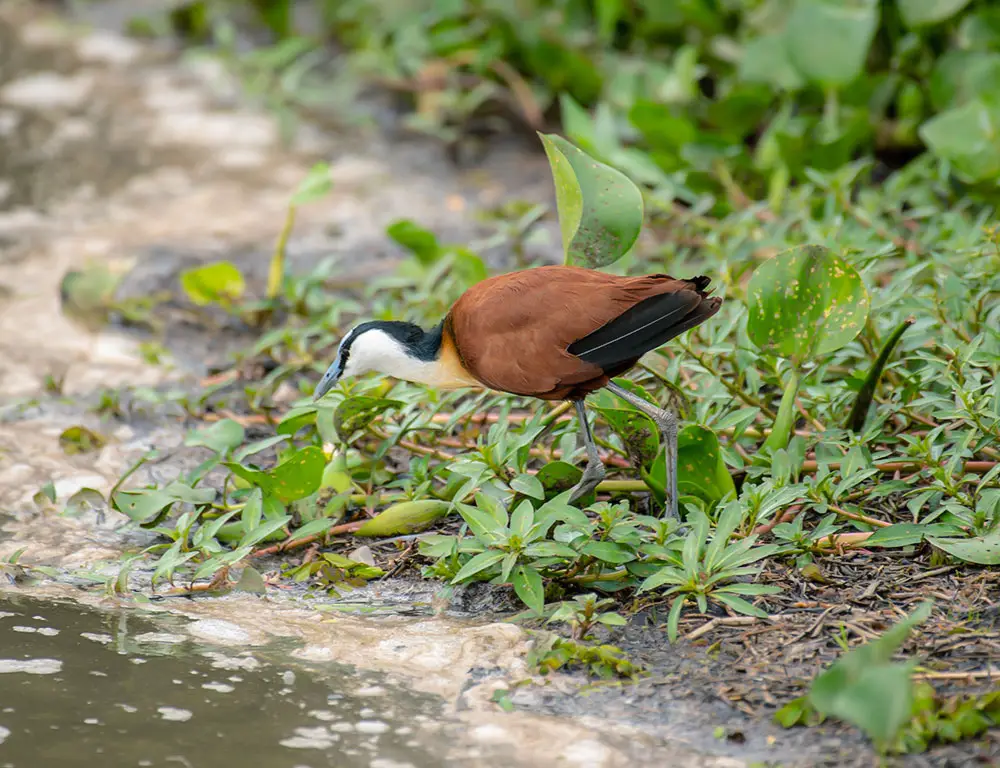
Here’s a table detailing the taxonomy of the Jacana bird:
| Taxonomic Rank | Classification |
| Domain | Eukaryota |
| Kingdom | Animalia |
| Phylum | Chordata |
| Class | Aves |
| Order | Charadriiformes |
| Family | Jacanidae |
| Genus | Jacana |
| Species | Jacana spinosa |
The Jacana bird, scientifically known as Jacana spinosa, belongs to the Animalia kingdom, Chordata phylum, and Aves class. It is categorized under the Charadriiformes order and the Jacanidae family.
Within the Jacanidae family, it is classified under the Jacana genus. Jacanas are unique wading birds in tropical and subtropical wetlands, characterized by their long legs, elongated toes, and vivid plumage.
They are renowned for their ability to walk on floating vegetation and their distinct mating system. Jacanas play critical ecological roles in their habitats, contributing to the biodiversity of wetland ecosystems.
Hunting Habit of Jacanas
Jacanas are opportunistic feeders with varied hunting habits primarily focused on foraging in and around shallow water habitats.
Their long legs and toes delicately traverse floating vegetation and shallow waters, probing mud and vegetation with their slender bills.
Their diet consists mainly of insects, small invertebrates, seeds, and other aquatic prey.
They employ a combination of visual and tactile cues to detect and capture prey, using their keen eyesight to spot movement on the water’s surface and their sensitive bills to locate hidden food items beneath the surface.
Jacanas are adept at capturing prey on land and in water, utilizing their agility and stealth to surprise their quarry.
Slow and deliberate movements often characterize their hunting behavior as they methodically search for food amidst the dense vegetation of their wetland habitats.
Jacanas Life History
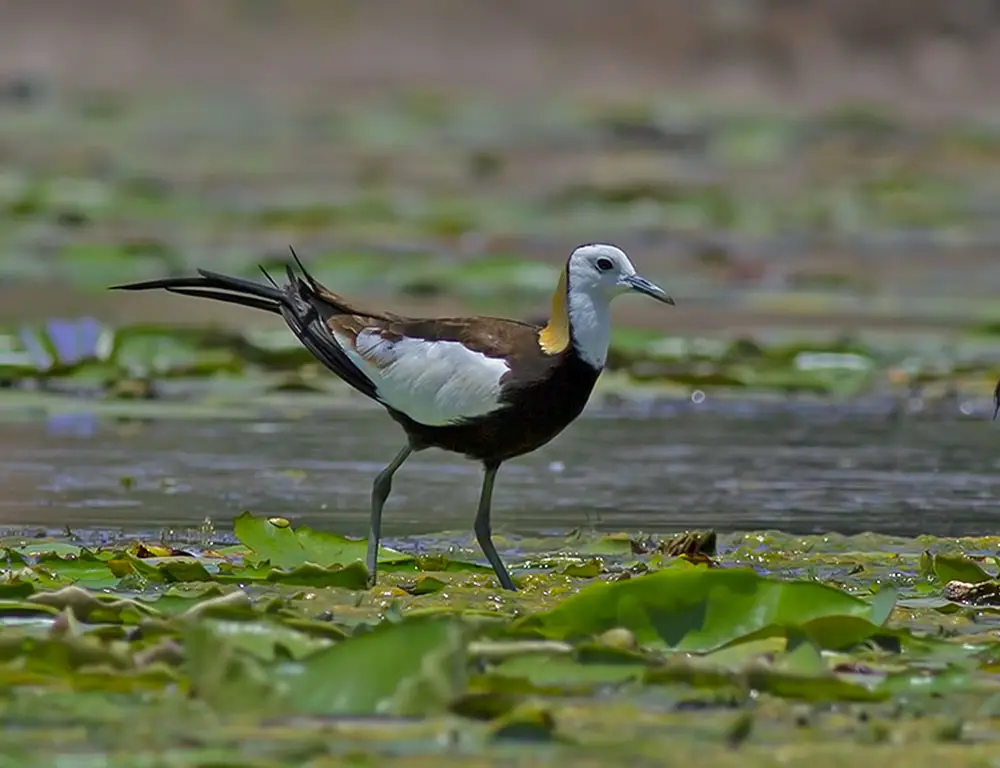
With their striking appearance and unique behaviors, Jacanas are fascinating birds found in tropical and subtropical wetlands worldwide.
Their history encompasses various aspects, from foraging and nesting habits to breeding behaviors and conservation challenges.
Food
Jacanas, carnivorous birds, employ their bills to flip lily pads and aquatic vegetation, unveiling a buffet of insects, snails, worms, small crabs, fish, mollusks, and seeds.
Using adept toe grasping, they deftly manipulate their environment, securing sustenance from a diverse array of prey hidden beneath the surface.
Habitat
Jacanas thrive in the watery realms of swamps, shallow lakes, marshes, and lagoons, where they find sanctuary amidst lily pads and floating vegetation, their habitat rich in resources and shelter.
Range Map
Jacanas are found in regions across the globe, including Africa, Asia, Australia, and the Americas. Their range map typically covers tropical and subtropical regions, with some species being endemic to specific areas.
Nesting
Jacanas construct nests on floating vegetation or overhanging branches above water. The female typically lays eggs in multiple nests, while the male incubates the eggs and cares for the chicks.
Here’s a table detailing the nesting details of Jacanas:
| Nesting Details | Description |
| Clutch Size | Typically 3-4 eggs per clutch |
| Number of Broods | Often have multiple broods per breeding season |
| Egg Length | Approximately 3-4 centimeters |
| Egg Width | Approximately 2-3 centimeters |
| Incubation Period | Around 22-28 days |
| Nestling Period | Nestlings fledge at about 6-7 weeks of age |
| Egg Description | Eggs are usually pale brown or buff with dark speckles or markings |
Breeding
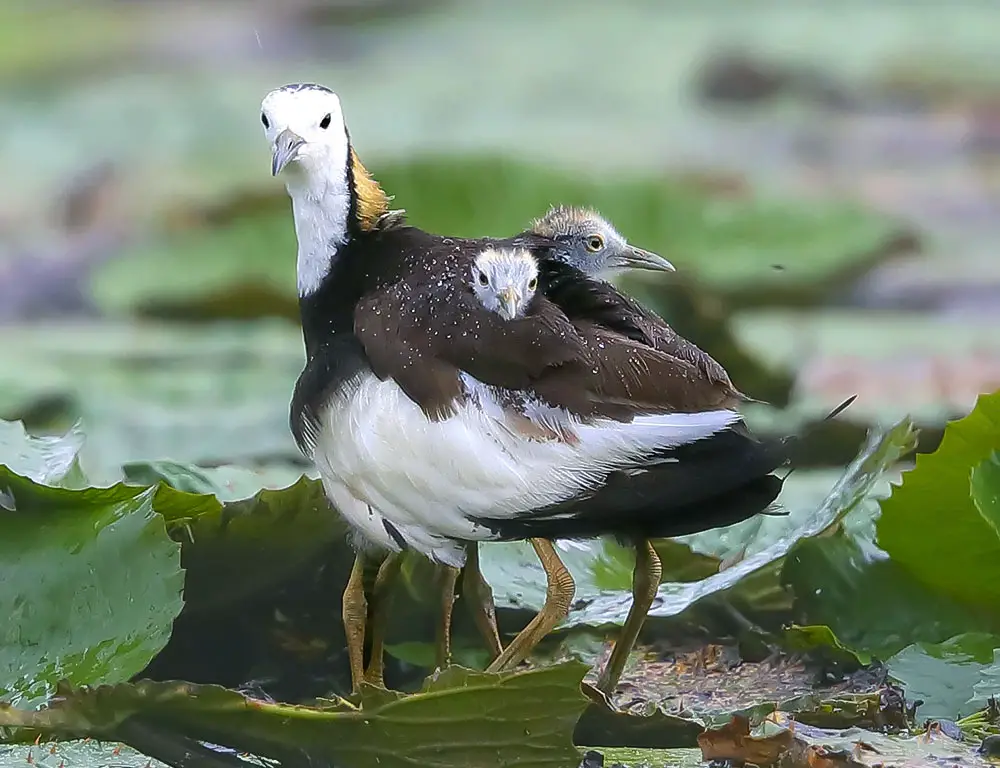
Jacanas exhibit polyandry, where females mate with multiple males and leave the males to incubate the eggs and care for the offspring. Males aggressively defend territories and may engage in courtship displays to attract females.
Diseases
Jacanas may be susceptible to various diseases and parasites common to wetland birds, including avian botulism, avian influenza, and parasites such as blood flukes and nematodes.
Treatment
Treatment for diseases in jacanas typically involves supportive care and management of symptoms. In cases of outbreaks, conservation efforts may include monitoring and quarantine measures to prevent further spread among populations.
Conservation Status
Jacanas are not extinct and are considered very common in some regions of their natural habitat.
However, they face potential vulnerability due to the loss and degradation of wetland habitats.
Conservation efforts are crucial to safeguard these unique birds and preserve the delicate ecosystems they rely on for survival.
10 Fun Facts About Jacanas
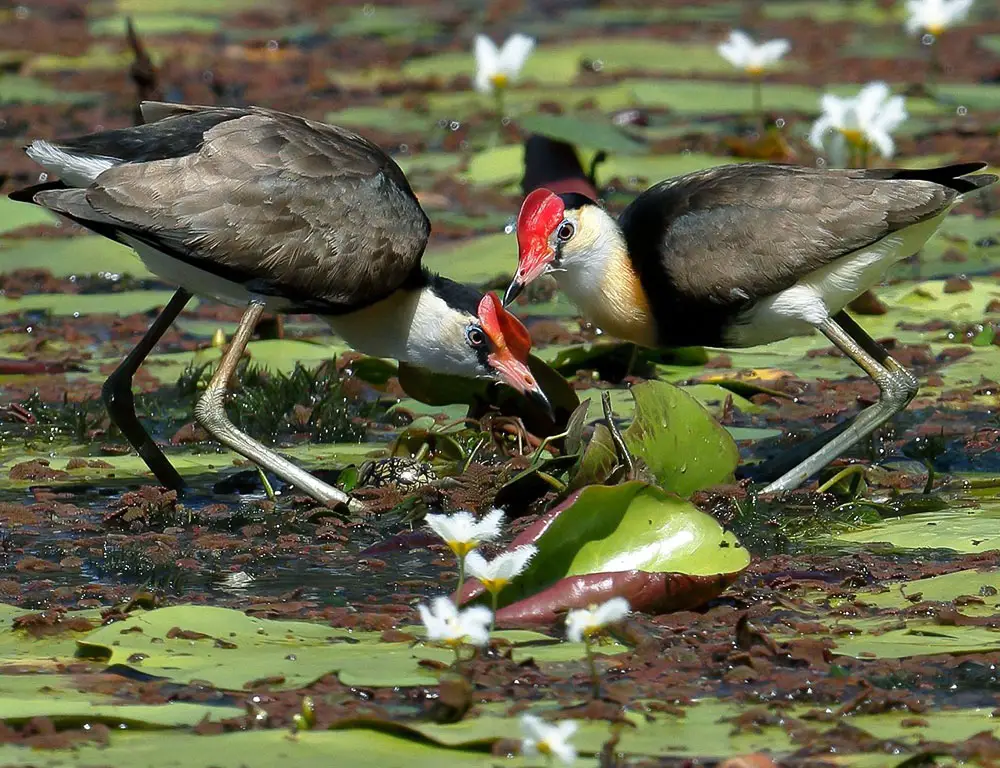
Jacanas, known as “lily-trotters,” are impressive birds in tropical and subtropical wetlands worldwide. Their unique characteristics and behaviors make them fascinating subjects for bird enthusiasts.
Here are 10 fun facts about jacanas:
- Walking on Water: Jacanas are renowned for their ability to walk on floating vegetation, earning them the nickname “Jesus birds” due to their seemingly miraculous walking on water.
- Polyandrous Mating System: In a remarkable reversal of roles, female jacanas mate with multiple males and leave them to care for the eggs and young. At the same time, they defend territories and seek out additional mates.
- Loud Vocalizations: Despite their small size, jacanas are surprisingly loud birds, emitting various calls and vocalizations to communicate with each other and defend their territories.
- Elongated Toes: Jacanas have exceptionally long toes, which help distribute their weight evenly as they walk on floating vegetation and through dense marshes.
- Insectivorous Diet: These birds primarily feed on insects, small invertebrates, seeds, and aquatic vegetation, using their long bills to probe mud and vegetation for prey.
- vivid Plumage: Jacanas exhibit striking plumage, with males often displaying brighter colors during the breeding season to attract mates.
- Nest Building: Jacanas construct nests on floating vegetation or overhanging branches above water, using various plant materials and sometimes even reusing old nests.
- Aggressive Defense: Male jacanas fiercely defend their territories from intruders, engaging in aggressive displays and vocalizations to ward off potential threats.
- Global Distribution: Jacanas are found in regions across the globe, including Africa, Asia, Australia, and the Americas, inhabiting a wide range of wetland habitats.
- Conservation Challenges: Despite their adaptability, jacanas face threats from habitat loss, pollution, and climate change, highlighting the need for conservation efforts to protect these unique birds and their wetland ecosystems.
Wrapping Up
Jacanas exemplify the remarkable adaptability of avian species to diverse wetland habitats.
With their distinctive long toes, sharp bills, and agile foraging techniques, they navigate the intricate ecosystems of swamps, shallow lakes, marshes, and lagoons with finesse.
While currently not endangered and often abundant in parts of their range, jacanas are not immune to the threats posed by habitat loss and degradation.
As stewards of our planet’s natural treasures, it is imperative to prioritize conservation efforts aimed at preserving the wetlands upon which jacanas depend.
By safeguarding their habitats, we not only protect the charismatic jacanas but also uphold the delicate balance of these vital ecosystems.
Through continued research, education, and proactive conservation initiatives, we can ensure a future where jacanas continue to grace our wetlands, enriching our lives and reminding us of the interconnectedness of all living beings within the intricate web of life.